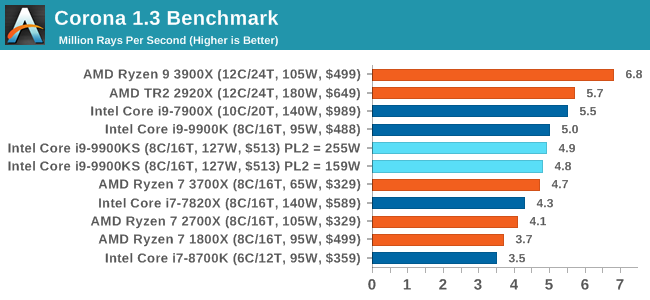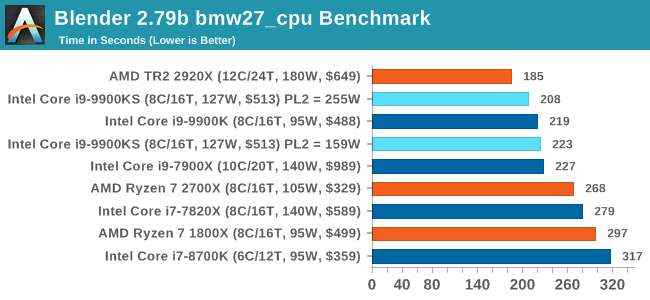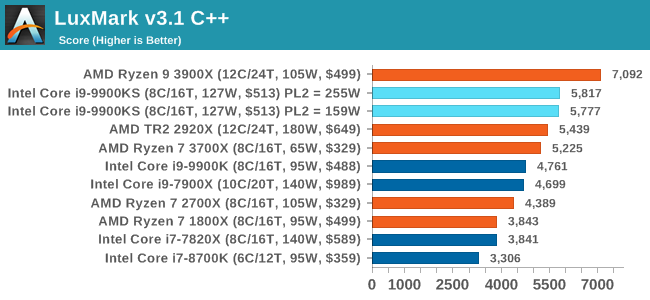The Intel Core i9-9900KS Review: The 5 GHz Consumer Special
by Dr. Ian Cutress on October 31, 2019 10:45 AM ESTCPU Performance: Rendering Tests
Rendering is often a key target for processor workloads, lending itself to a professional environment. It comes in different formats as well, from 3D rendering through rasterization, such as games, or by ray tracing, and invokes the ability of the software to manage meshes, textures, collisions, aliasing, physics (in animations), and discarding unnecessary work. Most renderers offer CPU code paths, while a few use GPUs and select environments use FPGAs or dedicated ASICs. For big studios however, CPUs are still the hardware of choice.
All of our benchmark results can also be found in our benchmark engine, Bench.
Corona 1.3: Performance Render
An advanced performance based renderer for software such as 3ds Max and Cinema 4D, the Corona benchmark renders a generated scene as a standard under its 1.3 software version. Normally the GUI implementation of the benchmark shows the scene being built, and allows the user to upload the result as a ‘time to complete’.
We got in contact with the developer who gave us a command line version of the benchmark that does a direct output of results. Rather than reporting time, we report the average number of rays per second across six runs, as the performance scaling of a result per unit time is typically visually easier to understand.
The Corona benchmark website can be found at https://corona-renderer.com/benchmark

Interestingly both 9900KS settings performed slightly worse than the 9900K here, which you wouldn't expect given the all-core turbo being higher. It would appear that there is something else the bottleneck in this test.
Blender 2.79b: 3D Creation Suite
A high profile rendering tool, Blender is open-source allowing for massive amounts of configurability, and is used by a number of high-profile animation studios worldwide. The organization recently released a Blender benchmark package, a couple of weeks after we had narrowed our Blender test for our new suite, however their test can take over an hour. For our results, we run one of the sub-tests in that suite through the command line - a standard ‘bmw27’ scene in CPU only mode, and measure the time to complete the render.
Blender can be downloaded at https://www.blender.org/download/

All the 9900 parts and settings perform roughly the same with one another, however the PL2 255W setting on the 9900KS does allow it to get a small ~5% advantage over the standard 9900K.
LuxMark v3.1: LuxRender via Different Code Paths
As stated at the top, there are many different ways to process rendering data: CPU, GPU, Accelerator, and others. On top of that, there are many frameworks and APIs in which to program, depending on how the software will be used. LuxMark, a benchmark developed using the LuxRender engine, offers several different scenes and APIs.
In our test, we run the simple ‘Ball’ scene on both the C++ and OpenCL code paths, but in CPU mode. This scene starts with a rough render and slowly improves the quality over two minutes, giving a final result in what is essentially an average ‘kilorays per second’.

Both 9900KS settings perform equally well here, and a sizeable jump over the standard 9900K.
POV-Ray 3.7.1: Ray Tracing
The Persistence of Vision ray tracing engine is another well-known benchmarking tool, which was in a state of relative hibernation until AMD released its Zen processors, to which suddenly both Intel and AMD were submitting code to the main branch of the open source project. For our test, we use the built-in benchmark for all-cores, called from the command line.
POV-Ray can be downloaded from http://www.povray.org/

One of the biggest differences between the two power settings is in POV-Ray, with a marked frequency difference. In fact, the 159W setting on the 9900KS puts it below our standard settings for the 9900K, which likely had an big default turbo budget on the board it was on at the time.











235 Comments
View All Comments
AshlayW - Friday, November 1, 2019 - link
'Hater's dislike this CPU because once again Intel is relying on marketing ploys and borderline mis-information to sell recycled parts based on tech from 2015, at a price that is higher than the competition's part with 4 more cores, signficnatly higher MT perf, higher efficiency, an included cooler, it's not EOL like Z390, etc. Do you see what I'm saying? these 'haters' are sick and tired of Intel's stranglehold on price-gauging the CPU market and they voice their opinions now that we have some really viable competition. Shocker: people care about value and features.nathanddrews - Friday, November 1, 2019 - link
And to some customers, this chip has the features they want at a value level they can afford. I'm not sure why that's so difficult a concept to understand. Rather, I think that the "haters" understand perfectly well, they irrationally fear what other people purchase.Spunjji - Friday, November 1, 2019 - link
None of what you said discounts what he said - it's just whataboutism followed by some unflattering generalisations about people you think you disagree with. :|GreenReaper - Saturday, November 2, 2019 - link
It's not fear; it's pity.brantron - Thursday, October 31, 2019 - link
What does the ring bus clock run at by default? If it's still 3.7 - 4 GHz, these may be a little more overclockable than the turbo clock implies.I'm curious how the power and temperature compares to the regular 9900K with everything pushed as far as it will go.
If and when there's a desktop Comet Lake, I'd also like to see a comparison from Skylake and on. With chiplets, CPU manufacturing processes may no longer completely go out of style, so it would be interesting to see how 14nm progressed over 5 years.
Alistair - Thursday, October 31, 2019 - link
It's kind of funny, that the only thing different about this 9900k is the possible voltage that it might be able to run at, and he didn't test that. "voltage" is nowhere to be found in this review. I.e. this CPU is just a 9900k, nothing improved. Just set your voltage to 1.3V with a normal 9900k and set 5ghz, there, the same. This by all rights will be crushed by the 3950x, I'd rather take double the cores for almost the same money, imo.TEAMSWITCHER - Thursday, October 31, 2019 - link
"I'd rather take double the cores for almost the same money".I jumped on the 9900K long before Zen 2 even had a release date. I'm not disappointed with the performance I get in multi-threaded tasks, certainly not enough to spend $1000 to switch platforms. AMD's 3900X and (eventually) the 3950X might have more cores but it's going to be at least two years before I buy another platform. Instead, I will use that $1000 to purchase an RTX 3080Ti the very instant nvidia puts them up for sale.
Korguz - Thursday, October 31, 2019 - link
heh,.. and you really think nvidia is going to charge 1k for a 3080Ti ??? more like 2000+Alistair - Thursday, October 31, 2019 - link
um... you could have just kept the 8700k instead if you wanted the ST performance, that hasn't changedTEAMSWITCHER - Friday, November 1, 2019 - link
What makes you think I had an 8700K? My previous platform was an Intel Core i7 5930K on an X99 Deluxe motherboard. The jump from 6 - 8 cores wasn't huge, but the Coffee Lake cores are faster than the Haswell-E - my Cinebench score still doubled. However, Cinebench is kind of stupid now, and why I dropped the HEDT platform. I'd rather spend more on a GPU, not just for great 4K gaming, but Blender can do faster rendering on a GPU, and you can also use your GPU to accelerate video encoding. 8 cores and 16 threads is plenty for everything else.